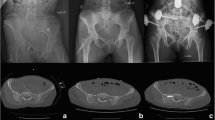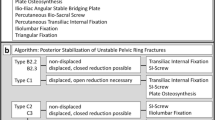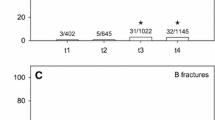Abstract
Purpose
Open surgical management of unstable pelvic ring injuries has been discussed controversially compared to percutaneous techniques in terms of surgical site morbidity especially in older patients. Thus, we assessed the impact of age on the outcome following fixation of unstable pelvic ring injuries through the modified Stoppa approach.
Methods
Out of a consecutive series of 92 patients eligible for the study, 63 patients (mean age 50 years, range 19–78) were evaluated [accuracy of reduction, complications, failures, Majeed-Score, Oswestry Disability Questionnaire (ODI), Mainz Pain Staging System (MPSS)] at a mean follow-up of 3.3 years (range 1.0–7.9). Logistic multivariate regression analysis was performed to assess the outcome in relation to increasing patient age and/or Injury Severity Score (ISS).
Results
Out of 63 patients, in 36 an “anatomic” reduction was achieved. Ten postoperative complications occurred in eight patients. In five patients, failure of fixation was noted at the anterior and/or posterior pelvic ring. In 49 patients, an “excellent” or “good” Majeed-Score was obtained; the mean ODI was 14 % (range 0–76 %); 50 patients reported either no or only minor chronic pelvic pain (MPSS). Only an increasing ISS conferred an increased likelihood of the occurrence of a non-anatomical reduction, a “poor” or “fair” Majeed-Score, or an ODI >20 %.
Conclusions
Increasing age did not impact the analysed parameters. Open reduction and internal fixation of the anterior pelvic ring through a modified Stoppa approach in unstable pelvic ring injuries did not result in an unfavourable outcome with increasing age of patients.
Similar content being viewed by others
References
Rommens PM. Is there a role for percutaneous pelvic and acetabular reconstruction? Injury. 2007;38(4):463–77.
Judet R, Judet J, Letournel E. Fractures of the acetabulum: classification and surgical approaches for open reduction. Preliminary report. J Bone Joint Surg Am. 1964;46:1615–46.
Matta JM. Indications for anterior fixation of pelvic fractures. Clin Orthop Relat Res. 1996;329:88–96.
Tile M. Pelvic ring fractures: should they be fixed? J Bone Joint Surg Br. 1988;70(1):1–12.
Cole JD, Bolhofner BR. Acetabular fracture fixation via a modified Stoppa limited intrapelvic approach. Description of operative technique and preliminary treatment results. Clin Orthop Relat Res. 1994;305:112–23.
Stoppa R, Petit J, Abourachid H, Henry X, Duclaye C, Monchaux G, et al. Original procedure of groin hernia repair: interposition without fixation of Dacron tulle prosthesis by subperitoneal median approach. Chirurgie. 1973;99(2):119–23.
Hirvensalo E, Lindahl J, Kiljunen V. Modified and new approaches for pelvic and acetabular surgery. Injury. 2007;38(4):431–41.
Ponsen KJ, Joosse P, Schigt A, Goslings JC, Luitse JS. Internal fracture fixation using the Stoppa approach in pelvic ring and acetabular fractures: technical aspects and operative results. J Trauma. 2006;61(3):662–7.
Culemann U, Marintschev I, Gras F, Pohlemann T. Infra-acetabular corridor–technical tip for an additional screw placement to increase the fixation strength of acetabular fractures. J Trauma. 2011;70(1):244–6.
Baker SP, O’Neill B, Haddon W Jr, Long WB. The injury severity score: a method for describing patients with multiple injuries and evaluating emergency care. J Trauma. 1974;14(3):187–96.
Dindo D, Demartines N, Clavien PA. Classification of surgical complications: a new proposal with evaluation in a cohort of 6336 patients and results of a survey. Ann Surg. 2004;240(2):205–13.
Sink EL, Leunig M, Zaltz I, Gilbert JC, Clohisy J. Reliability of a complication classification system for orthopaedic surgery. Clin Orthop Relat Res. 2012;470(8):2220–6.
Rommens PM, Hessmann MH. Staged reconstruction of pelvic ring disruption: differences in morbidity, mortality, radiologic results, and functional outcomes between B1, B2/B3, and C-type lesions. J Orthop Trauma. 2002;16(2):92–8.
Majeed SA. Grading the outcome of pelvic fractures. J Bone Joint Surg Br. 1989;71(2):304–6.
Roland M, Fairbank J. The Roland-Morris disability questionnaire and the Oswestry disability questionnaire. Spine. 2000;25(24):3115–24.
Gerbershagen HJ, Dagtekin O, Isenberg J, Martens N, Ozgur E, Krep H, et al. Chronic pain and disability after pelvic and acetabular fractures–assessment with the Mainz Pain Staging System. J Trauma. 2010;69(1):128–36.
Culemann U, Scola A, Tosounidis G, Pohlemann T, Gebhard F. Concept for treatment of pelvic ring injuries in elderly patients. A challenge. Unfallchirurg. 2010;113(4):258–71.
Meyhoff CS, Thomsen CH, Rasmussen LS, Nielsen PR. High incidence of chronic pain following surgery for pelvic fracture. Clin J Pain. 2006;22(2):167–72.
Kannus P, Palvanen M, Niemi S, Parkkari J, Jarvinen M. Epidemiology of osteoporotic pelvic fractures in elderly people in Finland: sharp increase in 1970-1997 and alarming projections for the new millennium. Osteoporos Int. 2000;11(5):443–8.
Cole PA, Gauger EM, Anavian J, Ly TV, Morgan RA, Heddings AA. Anterior pelvic external fixator versus subcutaneous internal fixator in the treatment of anterior ring pelvic fractures. J Orthop Trauma. 2012;26(5):269–77.
Lindahl J, Hirvensalo E, Bostman O, Santavirta S. Failure of reduction with an external fixator in the management of injuries of the pelvic ring. Long-term evaluation of 110 patients. J Bone Joint Surg Br. 1999;81(6):955–62.
Rommens PM, Wagner D, Hofmann A. Osteoporotic fractures of the pelvic ring. Z Orthop Unfall. 2012;150(3):e107–18.
Gardner MJ, Mehta S, Mirza A, Ricci WM. Anterior pelvic reduction and fixation using a subcutaneous internal fixator. J Orthop Trauma. 2012;26(5):314–21.
Hiesterman TG, Hill BW, Cole PA. Surgical technique: a percutaneous method of subcutaneous fixation for the anterior pelvic ring: the pelvic bridge. Clin Orthop Relat Res. 2012;470(8):2116–23.
Vaidya R, Kubiak EN, Bergin PF, Dombroski DG, Critchlow RJ, Sethi A, et al. Complications of anterior subcutaneous internal fixation for unstable pelvis fractures: a multicenter study. Clin Orthop Relat Res. 2012;470(8):2124–31.
Vaidya R, Colen R, Vigdorchik J, Tonnos F, Sethi A. Treatment of unstable pelvic ring injuries with an internal anterior fixator and posterior fixation: initial clinical series. J Orthop Trauma. 2012;26(1):1–8.
Routt ML Jr, Simonian PT, Grujic L. The retrograde medullary superior pubic ramus screw for the treatment of anterior pelvic ring disruptions: a new technique. J Orthop Trauma. 1995;9(1):35–44.
Kuttner M, Klaiber A, Lorenz T, Fuchtmeier B, Neugebauer R. The pelvic subcutaneous cross-over internal fixator. Unfallchirurg. 2009;112(7):661–9.
Rommens PM, Hofmann A. Comprehensive classification of fragility fractures of the pelvic ring: recommendations for surgical treatment. Injury. 2013;44(12):1733–44.
Acknowledgments
We thank Paul Rodham, Newcastle, UK for linguistic help in the preparation of this manuscript. We thank Dr. Daniel Dietrich, Institute of Mathematical Statistics and Actuarial Science, University of Bern, Switzerland for performing the statistical analysis and his assistance in interpretation of the results.
Author information
Authors and Affiliations
Corresponding author
Ethics declarations
Conflict of interest
Johannes Dominik Bastian, Alexandre Ansorge, Salvatore Tomagra, Klaus Arno Siebenrock, Lorin Michael Benneker, Lorenz Büchler, Marius Johann Baptist Keel declare that they have no conflict of interest.
Ethical approval
The study was approved by the Institutional Review Board and was performed in compliance with ethical requirements.
Rights and permissions
About this article
Cite this article
Bastian, J.D., Ansorge, A., Tomagra, S. et al. Anterior fixation of unstable pelvic ring fractures using the modified Stoppa approach: mid-term results are independent on patients’ age. Eur J Trauma Emerg Surg 42, 645–650 (2016). https://doi.org/10.1007/s00068-015-0577-x
Received:
Accepted:
Published:
Issue Date:
DOI: https://doi.org/10.1007/s00068-015-0577-x




